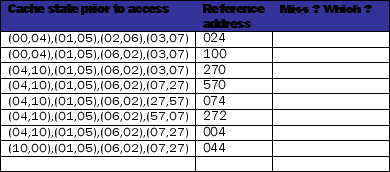Caches and Address Translation. Consider a 64-byte cache with 8 byte blocks, an associativity of 2 and LRU block replacement. Virtual addresses are 16 bits. The cache is physically tagged. The processor has 16KB of physical memory.
(a) What is the total number of tag bits?
(b) Assuming there are no special provisions for avoiding synonyms, what is the minimum page size?
(c) Assume each page is 64 bytes. How large would a single-level page table be given that each page requires 4 protection bits, and entries must be an integral number of bytes.
(d) For the following sequence of references, label the cache misses.Also, label each miss as being either a compulsory miss, a capacity miss, or a conflict miss. The addresses are given in octal (each digit represents 3 bits). Assume the cache initially contains block addresses: 000, 010, 020, 030, 040, 050, 060, and 070 which were accessed in that order

 (e) Which of the following techniques are aimed at reducing the cost of a miss: dividing the current block into sub-blocks, a larger block size, the addition of a second level cache, the addition of a victim buffer, early restart with critical word first, a writeback buffer, skewed associativity, software prefetching, the use of a TLB, and multi-porting.
(e) Which of the following techniques are aimed at reducing the cost of a miss: dividing the current block into sub-blocks, a larger block size, the addition of a second level cache, the addition of a victim buffer, early restart with critical word first, a writeback buffer, skewed associativity, software prefetching, the use of a TLB, and multi-porting.
(f) Why are the first level caches usually split (instructions and data are in different caches) while the L2 is usually unified (instructions and data are both in the same cache)?
Correct Answer:
Verified
View Answer
Unlock this answer now
Get Access to more Verified Answers free of charge
Q2: For a data cache with a 92%
Q3: Both DRAM and SRAM must be refreshed
Q4: A virtual cache access time is always
Q5: This question covers virtual memory access. Assume
Q6: Memory interleaving is a technique for reducing
Q8: A two part question
(a) Why is miss
Q9: The memory architecture of a machine X
Q10: What needs to be stored in a
Q11: A write-through cache typically requires less bus
Q12: The Average Memory Access Time equation
Unlock this Answer For Free Now!
View this answer and more for free by performing one of the following actions

Scan the QR code to install the App and get 2 free unlocks

Unlock quizzes for free by uploading documents